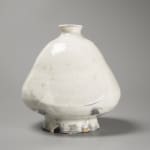Kondo Seiko 近藤 精宏
Kohiki Jar with Transparent Glaze 粉引扁壺
Stoneware
Diameter 7.5”x H1.7.8”
Diameter 19cm x H20cm
Diameter 19cm x H20cm
With Signed Wood Box
Sold
Further images
-
(View a larger image of thumbnail 1
)

-
(View a larger image of thumbnail 2
)

-
(View a larger image of thumbnail 3
)

-
(View a larger image of thumbnail 4
)

-
(View a larger image of thumbnail 5
)

-
(View a larger image of thumbnail 6
)

-
(View a larger image of thumbnail 7
)

-
(View a larger image of thumbnail 8
)

-
(View a larger image of thumbnail 9
)

-
(View a larger image of thumbnail 10
)

-
(View a larger image of thumbnail 11
)

-
(View a larger image of thumbnail 12
)

-
(View a larger image of thumbnail 13
)

-
(View a larger image of thumbnail 14
)

-
(View a larger image of thumbnail 15
)

Kondo Seiko (b. 1945) trained under the Karatsu legend and scholar, Koyama Fujio, whose research into Chinese glazes played a major part in defining the visual identity of modern Karatsu-yaki...
Kondo Seiko (b. 1945) trained under the Karatsu legend and scholar, Koyama Fujio, whose research into Chinese glazes played a major part in defining the visual identity of modern Karatsu-yaki today.
Koyama’s pottery in part played into his scholarly research, which also helped him define the eclectic identity of Karatsu-yaki today. He mastered many types of glazes in order to understand ceramic artistic production, and he was an avid reader and researcher into Chinese and Korean glazes and their development in Japanese ceramic history.
Kondo Seiko takes after his teacher in this sense, having mastered a range of Karatsu techniques imported from Korea. This white jar shows Kondo's fluency in the Kohiki glaze. The creamy semi-opaque white glaze showcases a soft, grey undertone, a classic color combination of the historical Kohiki bowls from the Korean peninsula. It showcases his commitment to studying the history of ceramics through his practice.
Koyama’s pottery in part played into his scholarly research, which also helped him define the eclectic identity of Karatsu-yaki today. He mastered many types of glazes in order to understand ceramic artistic production, and he was an avid reader and researcher into Chinese and Korean glazes and their development in Japanese ceramic history.
Kondo Seiko takes after his teacher in this sense, having mastered a range of Karatsu techniques imported from Korea. This white jar shows Kondo's fluency in the Kohiki glaze. The creamy semi-opaque white glaze showcases a soft, grey undertone, a classic color combination of the historical Kohiki bowls from the Korean peninsula. It showcases his commitment to studying the history of ceramics through his practice.














